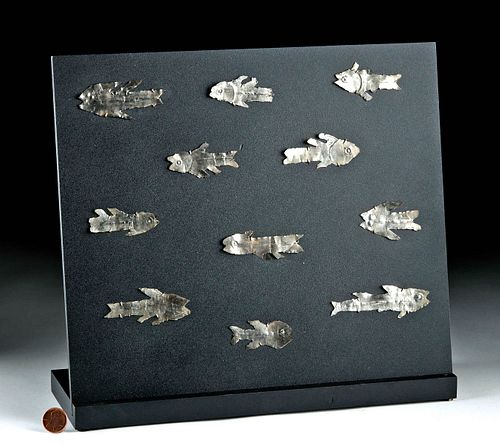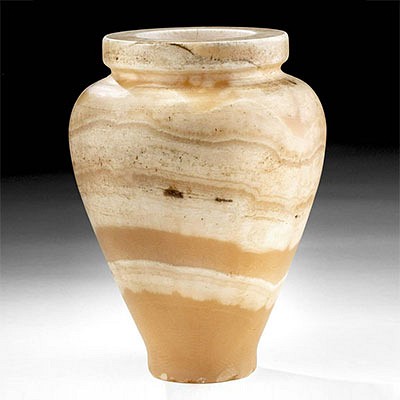Sican Lambayeque Silver Fish / Shark Votives (11)
Lot 112
About Seller
Artemis Fine Arts
686 S Taylor Ave, Ste 106
Louisville, CO 80027
United States
Selling antiquities, ancient and ethnographic art online since 1993, Artemis Gallery specializes in Classical Antiquities (Egyptian, Greek, Roman, Near Eastern), Asian, Pre-Columbian, African / Tribal / Oceanographic art. Our extensive inventory includes pottery, stone, metal, wood, glass and textil...Read more
Categories
Estimate:
$1,000 - $1,500
Absentee vs Live bid
Two ways to bid:
- Leave a max absentee bid and the platform will bid on your behalf up to your maximum bid during the live auction.
- Bid live during the auction and your bids will be submitted real-time to the auctioneer.
Bid Increments
| Price | Bid Increment |
|---|---|
| $0 | $25 |
| $300 | $50 |
| $1,000 | $100 |
| $2,000 | $250 |
| $5,000 | $500 |
| $10,000 | $1,000 |
| $20,000 | $2,500 |
| $50,000 | $5,000 |
| $100,000 | $10,000 |
| $200,000 | $20,000 |
About Auction
By Artemis Fine Arts
Dec 17, 2020
Set Reminder
2020-12-17 10:00:00
2020-12-17 10:00:00
America/New_York
Bidsquare
Bidsquare : VARIETY SALE | Antiquities & Ethnographic Art
https://www.bidsquare.com/auctions/artemis-gallery/variety-sale-antiquities-ethnographic-art-6207
Featuring classical antiquities, ancient and ethnographic art from cultures encompassing the globe. Egyptian, Greek, Roman, Etruscan, Near Eastern, Asian, Pre-Columbian, Native American, African / Tribal, Oceanic, Spanish Colonial, Russian, Fossils, Fine Art, more! Artemis Fine Arts info@artemisfinearts.com
Featuring classical antiquities, ancient and ethnographic art from cultures encompassing the globe. Egyptian, Greek, Roman, Etruscan, Near Eastern, Asian, Pre-Columbian, Native American, African / Tribal, Oceanic, Spanish Colonial, Russian, Fossils, Fine Art, more! Artemis Fine Arts info@artemisfinearts.com
- Lot Description
Pre-Columbian, north coast of Peru, Sican / Lambayeque culture, ca. 750 to 1370 CE. Eleven silver votives or appliques comprised of 98% silver, each one skillfully hammered and cut into the form of a swimming shark or fish. These special appliques were likely made to embellish a tunic or other textile and demonstrate the power and might of Sican rulers. Precious metals like silver were used by the ancients of the Americas to create vessels, headdresses, funerary masks, tumis, as well as body/clothing adornments like these for elite members of society. Size: longest fish measures 3.25" L (8.3 cm); ensemble measures 11.125" H (28.3 cm) x 12" W (30.5 cm) on included custom stand.
It is possible that these sea creatures were intended to be associated with Naymlap (also Naylamp, Nanlap, or Nylamp), the traditional founder of the Lambayeque dynasty, who was oftentimes depicted riding in a caballito de tortora (reed boat) and who came from the south by sea and colonized the region before he allegedly sprouted wings and flew off into the sunset in a dramatic display of his magical powers. Of course, as predatory animals, sharks also played a prominent role in demonstrating a ruler's might and fearsome nature.
Provenance: private Hawaii, USA collection; ex-Gary Drimmer collection, Chicago, Illinois, USA before 2000
All items legal to buy/sell under U.S. Statute covering cultural patrimony Code 2600, CHAPTER 14, and are guaranteed to be as described or your money back.
A Certificate of Authenticity will accompany all winning bids.
We ship worldwide and handle all shipping in-house for your convenience.
#144588Unable to weigh as these are attached to a custom stand. Each shows expected creases and minor bending with minute nicks to peripheries. Still remarkably well preserved.Condition
- Shipping Info
-
All shipping is handled in-house for your convenience. Your invoice from Artemis Gallery will include shipping calculation instructions. If in doubt, please inquire BEFORE bidding for estimated shipping costs for individual items.
-
- Buyer's Premium



 EUR
EUR CAD
CAD AUD
AUD GBP
GBP MXN
MXN HKD
HKD CNY
CNY MYR
MYR SEK
SEK SGD
SGD CHF
CHF THB
THB














